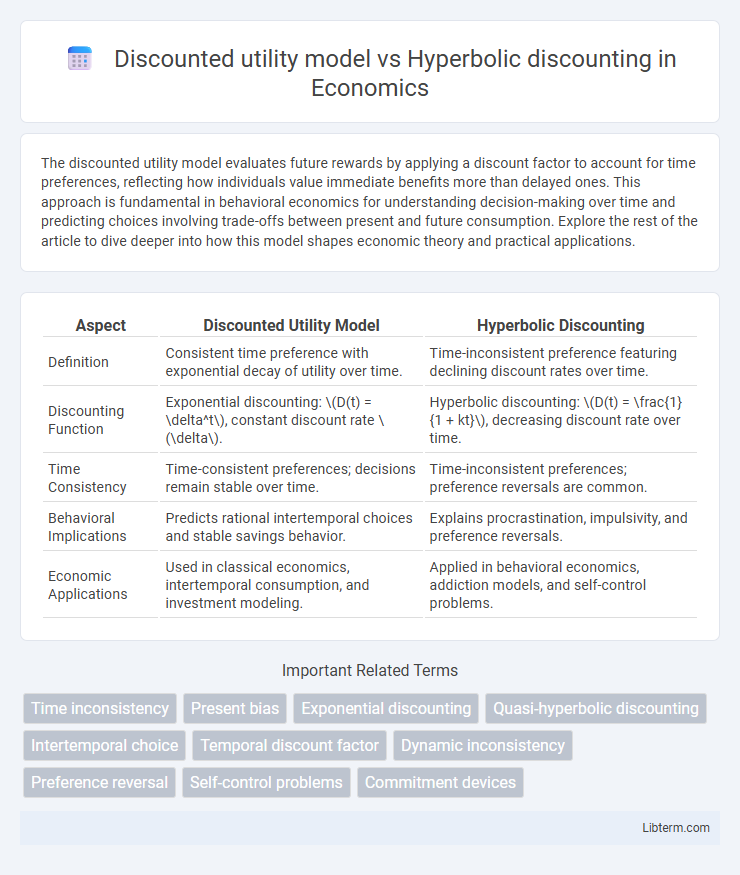The discounted utility model evaluates future rewards by applying a discount factor to account for time preferences, reflecting how individuals value immediate benefits more than delayed ones. This approach is fundamental in behavioral economics for understanding decision-making over time and predicting choices involving trade-offs between present and future consumption. Explore the rest of the article to dive deeper into how this model shapes economic theory and practical applications.
Table of Comparison
| Aspect | Discounted Utility Model | Hyperbolic Discounting |
|---|---|---|
| Definition | Consistent time preference with exponential decay of utility over time. | Time-inconsistent preference featuring declining discount rates over time. |
| Discounting Function | Exponential discounting: \(D(t) = \delta^t\), constant discount rate \(\delta\). | Hyperbolic discounting: \(D(t) = \frac{1}{1 + kt}\), decreasing discount rate over time. |
| Time Consistency | Time-consistent preferences; decisions remain stable over time. | Time-inconsistent preferences; preference reversals are common. |
| Behavioral Implications | Predicts rational intertemporal choices and stable savings behavior. | Explains procrastination, impulsivity, and preference reversals. |
| Economic Applications | Used in classical economics, intertemporal consumption, and investment modeling. | Applied in behavioral economics, addiction models, and self-control problems. |
Introduction to Intertemporal Choice
Intertemporal choice examines how individuals value rewards at different points in time, with the discounted utility model assuming a consistent exponential discount rate that leads to time-consistent preferences. Hyperbolic discounting challenges this by demonstrating declining discount rates over time, resulting in present-biased preferences and dynamic inconsistency. Understanding these models is essential for analyzing human decision-making in economics, finance, and behavioral sciences.
Understanding the Discounted Utility Model
The Discounted Utility Model explains decision-making by discounting future rewards exponentially based on a constant rate, reflecting time-consistent preferences across periods. It assumes individuals evaluate future utilities by applying a fixed discount factor, leading to dynamic consistency in choices over time. This model contrasts with Hyperbolic Discounting, which captures decreasing impatience and preference reversals by applying a declining discount rate, highlighting time-inconsistent behavior.
Key Principles of Hyperbolic Discounting
Hyperbolic discounting highlights the tendency to prefer smaller, immediate rewards over larger, delayed ones, reflecting decreasing impatience as delays lengthen. Unlike the constant discount rate in the Discounted Utility Model (DUM), hyperbolic discounting involves a declining discount rate over time, capturing dynamically inconsistent preferences. This model explains procrastination and impulsive decisions by emphasizing how present bias affects intertemporal choice differently than traditional exponential discounting.
Mathematical Foundations of Each Model
The Discounted Utility Model employs exponential discounting in its mathematical foundation, characterized by a constant discount rate, mathematically represented as U = S d^t * u(c_t), where d is the discount factor and u(c_t) is the utility of consumption at time t. Hyperbolic discounting diverges by using a hyperbolic function, typically expressed as U = S (1/(1 + kt)) * u(c_t), with k representing the discount rate parameter that decreases over time, reflecting more impulsive preferences. The key mathematical difference lies in the time inconsistency of hyperbolic functions versus the time-consistent exponential decay in the discounted utility model.
Contrasts in Time Preference Predictions
The Discounted Utility Model predicts consistent exponential decline in the value of future rewards, indicating stable time preferences over different time horizons. Hyperbolic Discounting, by contrast, suggests a declining discount rate over time, leading to preference reversals and greater impulsivity for immediate rewards. This fundamental difference causes the Discounted Utility Model to anticipate steady patience, while Hyperbolic Discounting accounts for observed human behaviors like procrastination and inconsistent decision-making.
Real-World Examples: Discounted Utility vs Hyperbolic Discounting
The Discounted Utility model assumes consistent time preferences, often used in traditional economic analyses such as retirement savings where individuals value future income at a fixed rate. Hyperbolic discounting better explains real-world behaviors observed in cases like addiction or procrastination, where individuals disproportionately prefer immediate rewards over larger future benefits, leading to inconsistent decision-making over time. Studies on consumer credit card use and health interventions reveal hyperbolic discounting's impact on short-term impulsivity versus the long-term planning assumptions embedded in discounted utility models.
Behavioral Implications and Anomalies
The Discounted Utility Model assumes consistent time preferences and exponential discounting, predicting stable decision-making over time, whereas Hyperbolic Discounting reveals preference reversals and dynamic inconsistency due to stronger weighting of immediate rewards. Behavioral implications of hyperbolic discounting include procrastination, impulsivity, and suboptimal long-term planning, leading to anomalies such as time-inconsistent choices and preference reversals often observed in real-world decision scenarios. Understanding these differences informs interventions for self-control problems and enhances models of economic behavior, health decision-making, and addiction.
Experimental Evidence Supporting Each Model
Experimental evidence for the discounted utility model shows consistent exponential discounting patterns in choices involving delayed monetary rewards, supporting time-consistent preferences in controlled economic settings. Hyperbolic discounting, however, is empirically validated by behavioral studies demonstrating preference reversals and impulsive choices, particularly in intertemporal decisions related to health and addiction, revealing present-bias and decreasing discount rates over longer delays. Neuroeconomic experiments using fMRI also highlight distinct neural correlates for immediate versus delayed rewards, further differentiating hyperbolic discounting from the traditional discounted utility framework.
Applications in Economics and Psychology
The Discounted Utility Model, widely used in economics, assumes consistent time preferences and helps predict intertemporal choices in financial planning and consumer behavior analysis. Hyperbolic discounting, prominent in psychology, captures time-inconsistent preferences and explains phenomena like procrastination, addiction, and impulsive decision-making. Both models inform policy design for savings, health interventions, and behavioral nudges by addressing how individuals evaluate future rewards and costs differently.
Conclusion: Choosing Between the Models
Discounted utility models provide a consistent framework for intertemporal choice by applying a constant discount rate to future utilities, ensuring time-consistent decisions. Hyperbolic discounting better captures observed behaviors like preference reversals and impulsivity by using a decreasing discount rate over time, reflecting time-inconsistent preferences. Choosing between these models depends on the context: discounted utility is suited for normative analysis and long-term planning, while hyperbolic discounting is more descriptive of real human behavior in economic and psychological studies.
Discounted utility model Infographic

 libterm.com
libterm.com